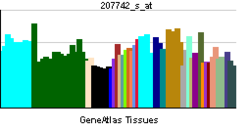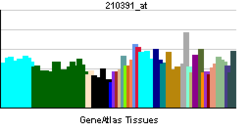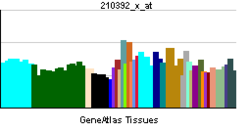- Germ cell nuclear factor
-
The germ cell nuclear factor (GCNF), also known as RTR (retinoid receptor-related testis-associated receptor) or NR6A1 (nuclear receptor subfamily 6, group A, member 1), is a protein that in humans is encoded by the NR6A1 gene.[1][2] GCNF is a member of the nuclear receptor family of intracellular transcription factors .
In adults, GCNH is expressed mainly in the germ cells of gonads and is involved in the regulation of embryogenesis and germ cell differentiation.[3]
Its expression pattern suggests that it may be involved in neurogenesis and germ cell development. The protein can homodimerize and bind DNA, but in vivo targets have not been identified. The gene expresses three alternatively spliced transcript variants.[4]
References
- ^ Lei W, Hirose T, Zhang LX, Adachi H, Spinella MJ, Dmitrovsky E, Jetten AM (1997). "Cloning of the human orphan receptor germ cell nuclear factor/retinoid receptor-related testis-associated receptor and its differential regulation during embryonal carcinoma cell differentiation". J. Mol. Endocrinol. 18 (2): 167–76. doi:10.1677/jme.0.0180167. PMID 9134503.
- ^ Süsens U, Borgmeyer U (1996). "Characterization of the human germ cell nuclear factor gene". Biochim. Biophys. Acta 1309 (3): 179–82. PMID 8982251.
- ^ Zechel C (2005). "The germ cell nuclear factor (GCNF)". Mol. Reprod. Dev. 72 (4): 550–6. doi:10.1002/mrd.20377. PMID 16155958.
- ^ "Entrez Gene: NR6A1 nuclear receptor subfamily 6, group A, member 1". http://www.ncbi.nlm.nih.gov/sites/entrez?Db=gene&Cmd=ShowDetailView&TermToSearch=2649.
Further reading
- Greschik H, Schüle R (1999). "Germ cell nuclear factor: an orphan receptor with unexpected properties.". J. Mol. Med. 76 (12): 800–10. doi:10.1007/s001090050284. PMID 9846950.
- Hirose T, O'Brien DA, Jetten AM (1995). "RTR: a new member of the nuclear receptor superfamily that is highly expressed in murine testis.". Gene 152 (2): 247–51. doi:10.1016/0378-1119(94)00656-D. PMID 7835709.
- Yan ZH, Medvedev A, Hirose T, et al. (1997). "Characterization of the response element and DNA binding properties of the nuclear orphan receptor germ cell nuclear factor/retinoid receptor-related testis-associated receptor.". J. Biol. Chem. 272 (16): 10565–72. doi:10.1074/jbc.272.16.10565. PMID 9099702.
- Kapelle M, Krätzschmar J, Husemann M, Schleuning WD (1997). "cDNA cloning of two closely related forms of human germ cell nuclear factor (GCNF).". Biochim. Biophys. Acta 1352 (1): 13–7. PMID 9177477.
- Agoulnik IY, Cho Y, Niederberger C, et al. (1998). "Cloning, expression analysis and chromosomal localization of the human nuclear receptor gene GCNF.". FEBS Lett. 424 (1–2): 73–8. doi:10.1016/S0014-5793(98)00142-2. PMID 9537518.
- Greschik H, Wurtz JM, Hublitz P, et al. (1999). "Characterization of the DNA-binding and dimerization properties of the nuclear orphan receptor germ cell nuclear factor.". Mol. Cell. Biol. 19 (1): 690–703. PMC 83926. PMID 9858592. http://www.pubmedcentral.nih.gov/articlerender.fcgi?tool=pmcentrez&artid=83926.
- Schmitz TP, Süsens U, Borgmeyer U (1999). "DNA binding, protein interaction and differential expression of the human germ cell nuclear factor.". Biochim. Biophys. Acta 1446 (3): 173–80. PMID 10524192.
- Yan Z, Jetten AM (2001). "Characterization of the repressor function of the nuclear orphan receptor retinoid receptor-related testis-associated receptor/germ cell nuclear factor.". J. Biol. Chem. 275 (45): 35077–85. doi:10.1074/jbc.M005566200. PMID 10940306.
- Süsens U, Borgmeyer U (2001). "Genomic structure of the gene for mouse germ-cell nuclear factor (GCNF). II. Comparison with the genomic structure of the human GCNF gene.". Genome Biol. 2 (5): RESEARCH0017. doi:10.1186/gb-2001-2-5-research0017. PMC 32189. PMID 11387038. http://www.pubmedcentral.nih.gov/articlerender.fcgi?tool=pmcentrez&artid=32189.
- Mehta DV, Kim YS, Dixon D, Jetten AM (2002). "Characterization of the expression of the retinoid-related, testis-associated receptor (RTR) in trophoblasts.". Placenta 23 (4): 281–7. doi:10.1053/plac.2001.0779. PMID 11969338.
- Yan Z, Kim YS, Jetten AM (2002). "RAP80, a novel nuclear protein that interacts with the retinoid-related testis-associated receptor.". J. Biol. Chem. 277 (35): 32379–88. doi:10.1074/jbc.M203475200. PMID 12080054.
- Lan ZJ, Chung AC, Xu X, et al. (2003). "The embryonic function of germ cell nuclear factor is dependent on the DNA binding domain.". J. Biol. Chem. 277 (52): 50660–7. doi:10.1074/jbc.M209586200. PMID 12381721.
- Strausberg RL, Feingold EA, Grouse LH, et al. (2003). "Generation and initial analysis of more than 15,000 full-length human and mouse cDNA sequences.". Proc. Natl. Acad. Sci. U.S.A. 99 (26): 16899–903. doi:10.1073/pnas.242603899. PMC 139241. PMID 12477932. http://www.pubmedcentral.nih.gov/articlerender.fcgi?tool=pmcentrez&artid=139241.
- Yang G, Zhang YL, Buchold GM, et al. (2003). "Analysis of germ cell nuclear factor transcripts and protein expression during spermatogenesis.". Biol. Reprod. 68 (5): 1620–30. doi:10.1095/biolreprod.102.012013. PMID 12606326.
- Rajkovic M, Middendorff R, Wetzel MG, et al. (2005). "Germ cell nuclear factor relieves cAMP-response element modulator tau-mediated activation of the testis-specific promoter of human mitochondrial glycerol-3-phosphate dehydrogenase.". J. Biol. Chem. 279 (50): 52493–9. doi:10.1074/jbc.M404467200. PMID 15456763.
- Gerhard DS, Wagner L, Feingold EA, et al. (2004). "The status, quality, and expansion of the NIH full-length cDNA project: the Mammalian Gene Collection (MGC).". Genome Res. 14 (10B): 2121–7. doi:10.1101/gr.2596504. PMC 528928. PMID 15489334. http://www.pubmedcentral.nih.gov/articlerender.fcgi?tool=pmcentrez&artid=528928.
External links
Transcription factors and intracellular receptors (1) Basic domains (1.1) Basic leucine zipper (bZIP)Activating transcription factor (AATF, 1, 2, 3, 4, 5, 6, 7) · AP-1 (c-Fos, FOSB, FOSL1, FOSL2, JDP2, c-Jun, JUNB, JUND) · BACH (1, 2) · BATF · BLZF1 · C/EBP (α, β, γ, δ, ε, ζ) · CREB (1, 3, L1) · CREM · DBP · DDIT3 · GABPA · HLF · MAF (B, F, G, K) · NFE (2, L1, L2, L3) · NFIL3 · NRL · NRF (1, 2, 3) · XBP1(1.2) Basic helix-loop-helix (bHLH)ATOH1 · AhR · AHRR · ARNT · ASCL1 · BHLHB2 · BMAL (ARNTL, ARNTL2) · CLOCK · EPAS1 · FIGLA · HAND (1, 2) · HES (5, 6) · HEY (1, 2, L) · HES1 · HIF (1A, 3A) · ID (1, 2, 3, 4) · LYL1 · MESP2 · MXD4 · MYCL1 · MYCN · Myogenic regulatory factors (MyoD, Myogenin, MYF5, MYF6) · Neurogenins (1, 2, 3) · NeuroD (1, 2) · NPAS (1, 2, 3) · OLIG (1, 2) · Pho4 · Scleraxis · SIM (1, 2) · TAL (1, 2) · Twist · USF1(1.3) bHLH-ZIP(1.4) NF-1(1.5) RF-X(1.6) Basic helix-span-helix (bHSH)(2) Zinc finger DNA-binding domains (2.1) Nuclear receptor (Cys4)subfamily 1 (Thyroid hormone (α, β), CAR, FXR, LXR (α, β), PPAR (α, β/δ, γ), PXR, RAR (α, β, γ), ROR (α, β, γ), Rev-ErbA (α, β), VDR)
subfamily 2 (COUP-TF (I, II), Ear-2, HNF4 (α, γ), PNR, RXR (α, β, γ), Testicular receptor (2, 4), TLX)
subfamily 3 (Steroid hormone (Androgen, Estrogen (α, β), Glucocorticoid, Mineralocorticoid, Progesterone), Estrogen related (α, β, γ))
subfamily 4 NUR (NGFIB, NOR1, NURR1) · subfamily 5 (LRH-1, SF1) · subfamily 6 (GCNF) · subfamily 0 (DAX1, SHP)(2.2) Other Cys4(2.3) Cys2His2General transcription factors (TFIIA, TFIIB, TFIID, TFIIE (1, 2), TFIIF (1, 2), TFIIH (1, 2, 4, 2I, 3A, 3C1, 3C2))
ATBF1 · BCL (6, 11A, 11B) · CTCF · E4F1 · EGR (1, 2, 3, 4) · ERV3 · GFI1 · GLI-Krüppel family (1, 2, 3, REST, S2, YY1) · HIC (1, 2) · HIVEP (1, 2, 3) · IKZF (1, 2, 3) · ILF (2, 3) · KLF (2, 3, 4, 5, 6, 7, 8, 9, 10, 11, 12, 13, 14, 15, 17) · MTF1 · MYT1 · OSR1 · PRDM9 · SALL (1, 2, 3, 4) · SP (1, 2, 4, 7, 8) · TSHZ3 · WT1 · Zbtb7 (7A, 7B) · ZBTB (16, 17, 20, 32, 33, 40) · zinc finger (3, 7, 9, 10, 19, 22, 24, 33B, 34, 35, 41, 43, 44, 51, 74, 143, 146, 148, 165, 202, 217, 219, 238, 239, 259, 267, 268, 281, 295, 300, 318, 330, 346, 350, 365, 366, 384, 423, 451, 452, 471, 593, 638, 644, 649, 655)(2.4) Cys6(2.5) Alternating composition(3) Helix-turn-helix domains (3.1) HomeodomainARX · CDX (1, 2) · CRX · CUTL1 · DBX (1, 2) · DLX (3, 4, 5) · EMX2 · EN (1, 2) · FHL (1, 2, 3) · HESX1 · HHEX · HLX · Homeobox (A1, A2, A3, A4, A5, A7, A9, A10, A11, A13, B1, B2, B3, B4, B5, B6, B7, B8, B9, B13, C4, C5, C6, C8, C9, C10, C11, C12, C13, D1, D3, D4, D8, D9, D10, D11, D12, D13) · HOPX · IRX (1, 2, 3, 4, 5, 6, MKX) · LMX (1A, 1B) · MEIS (1, 2) · MEOX2 · MNX1 · MSX (1, 2) · NANOG · NKX (2-1, 2-2, 2-3, 2-5, 3-1, 3-2, 6-1, 6-2) · NOBOX · PBX (1, 2, 3) · PHF (1, 3, 6, 8, 10, 16, 17, 20, 21A) · PHOX (2A, 2B) · PITX (1, 2, 3) · POU domain (PIT-1, BRN-3: A, B, C, Octamer transcription factor: 1, 2, 3/4, 6, 7, 11) · OTX (1, 2) · PDX1 · SATB2 · SHOX2 · VAX1 · ZEB (1, 2)(3.2) Paired box(3.3) Fork head / winged helix(3.4) Heat Shock Factors(3.5) Tryptophan clusters(3.6) TEA domain(4) β-Scaffold factors with minor groove contacts (4.1) Rel homology region(4.2) STAT(4.3) p53(4.4) MADS box(4.6) TATA binding proteins(4.7) High-mobility group(4.10) Cold-shock domainCSDA, YBX1(4.11) Runt(0) Other transcription factors (0.2) HMGI(Y)(0.3) Pocket domain(0.6) MiscellaneousCategories:- Human proteins
- Chromosome 9 gene stubs
- Intracellular receptors
- Transcription factors
Wikimedia Foundation. 2010.



